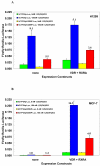A novel SNP in a vitamin D response element of the CYP24A1 promoter reduces protein binding, transactivation, and gene expression
- PMID: 18824104
- PMCID: PMC2749287
- DOI: 10.1016/j.jsbmb.2008.08.009
A novel SNP in a vitamin D response element of the CYP24A1 promoter reduces protein binding, transactivation, and gene expression
Erratum in
- J Steroid Biochem Mol Biol. 2010 Jan;118(1-2):133
Abstract
The active form of vitamin D (1alpha,25(OH)(2)D(3)) is known to have antiproliferative effects and has been implicated in cancers of the colon, breast, and prostate. These cancers occur more frequently among African Americans than Caucasians, and individuals with African ancestry are known to have approximately twofold lower levels of serum vitamin D (25(OH)D) compared with individuals of European ancestry. However, epidemiological studies of the vitamin D receptor (VDR) have shown inconsistent associations with cancer risk, suggesting that differences in other genes in the pathway may be important. We sought to identify functionally significant polymorphic variants in CYP24A1, a gene that is highly inducible by 1alpha,25(OH)(2)D(3) and that encodes the primary catabolic enzyme in the pathway. Here we report the identification of six novel SNPs in the human CYP24A1 promoter, including one at nucleotide -279 occurring within the distal vitamin D response element (VDRE2). Our experiments demonstrate that the VDRE2 variant results in decreased protein binding and transactivation in vitro, and reduced expression of CYP24A1 in cultured primary human lymphocytes provides evidence for an effect in vivo. This variant was only observed in our African American population, and represents a first step toward understanding differences in disease risk among racial/ethnic groups.
Figures




References
-
- Deeb KK, Trump DL, Johnson CS. Vitamin D signalling pathways in cancer: potential for anticancer therapeutics. Nat Rev Cancer. 2007;7(9):684–700. - PubMed
-
- Jin CH, Pike JW. Human vitamin D receptor-dependent transactivation in Saccharomyces cerevisiae requires retinoid X receptor. Molecular Endocrinology. 1996;10(2):196–205. - PubMed
-
- Harris SS, Dawson-Hughes B. Seasonal changes in plasma 25-hydroxyvitamin D concentrations of young American black and white women. Am J Clin Nutr. 1998;67(6):1232–1236. - PubMed
-
- Harris SS, Soteriades E, Coolidge JA, Mudgal S, Dawson-Hughes B. Vitamin D insufficiency and hyperparathyroidism in a low income, multiracial, elderly population. J Clin Endocrinol Metab. 2000;85(11):4125–4130. - PubMed
Publication types
MeSH terms
Substances
Grants and funding
LinkOut - more resources
Full Text Sources
Medical

